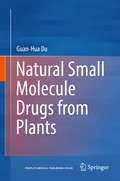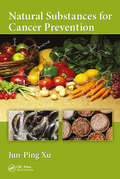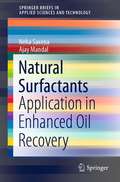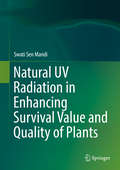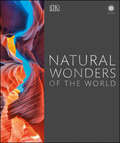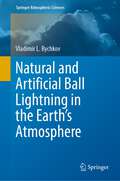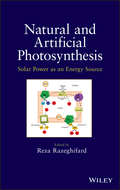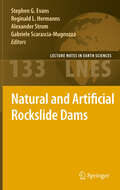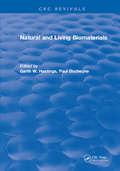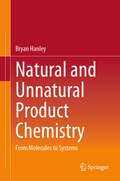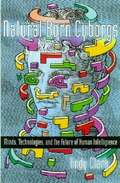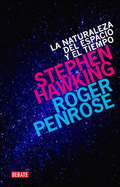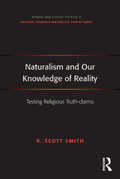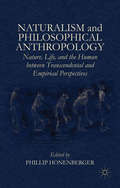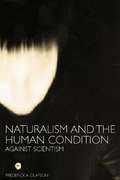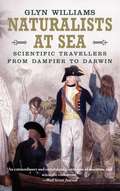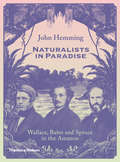- Table View
- List View
Natural Selections
by David P. Barash"Barash . . . brilliantly integrat[es] science, literature, and pop culture into elegant and insightful commentaries on the most interesting and important questions of our time. A delightful read."--Michael Shermer, author of The Science of Good and Evil "Entertaining and thought-provoking."--Steven Pinker, author of The Blank Slate If we are, in part, a product of our genes, can free will exist? Incisive and engaging, this indispensable tour of evolutionary biology runs the gamut of contemporary debates, from science and religion to our place in the universe.
Natural Small Molecule Drugs from Plants
by Guan-Hua DuThis book discusses 120 types of natural, small-molecule drugs derived from plants. They are grouped into 7 parts according their clinical uses, such as drugs for cardiovascular diseases, for metabolic diseases, for neuropsychiatric diseases, for immune-mediated inflammatory diseases, anti-tumor drugs, and drugs for parasites and bacterial infection. Each chapter systematically summarizes one drug, including its physicochemical properties, sources, pharmacological effects and clinical applications. To help readers understand the drug better, the research and pharmacological activity for each drug is also described, which serves as a salutary lesson for future drug development. Written by frontline researchers, teachers and clinicians working in field of pharmacy and pharmacology it provides an overview of natural, small-molecule drugs derived from plants for researchers in the field.
Natural Substances for Cancer Prevention
by Jun-Ping XuNatural Substances for Cancer Prevention explores in detail how numerous investigations in chemical biology and molecular biology have established strong scientific evidence demonstrating how the properties of naturally occurring bioactive chemicals hamper all stages of cancers (from initiation to metastasis). Accordingly, important goals for cancer prevention are the modification of our dietary habits and an increase in the intake of more anticancer-related natural substances. More significantly, the bioactive chemicals presented in the functional foods should be readily available, inexpensive, non-toxic, and nutritional.
Natural Surfactants: Application in Enhanced Oil Recovery (SpringerBriefs in Applied Sciences and Technology)
by Neha Saxena Ajay MandalThis book focuses on the use of natural surfactants in enhanced oil recovery, providing an overview of surfactants, their types, and different physical–chemical properties used to analyse the efficiency of surfactants. Natural surfactants discuss the history of the surfactants, their classification, and the use of surfactants in petroleum industry. Special attention has been paid to natural surfactants and their advantages over synthetic surfactants, including analysing their properties such as emulsification, interfacial tension, and wettability and how these can be used in EOR. This book offers an overview for researchers and graduate students in the fields of petroleum and chemical engineering, as well as oil and gas industry professionals.
Natural Systems
by Markus EichhornOrganised into four sections, this text discusses the organisation of the living world. Links Ecology, Biodiversity and Biogeography Bridges modern and conventional Ecology Builds sequentially from the concept and importance of species, through patterns of diversity to help consider global patterns of biogeography Uses real data sets to help train in essential skills
Natural UV Radiation in Enhancing Survival Value and Quality of Plants
by Swati Sen MandiThisbook is the first of its kind to highlight the positive impact of natural UVradiation on plants through unique adaptations in various metabolic pathways, andprovides an evolutionary sketch of the development of molecular mechanisms forprotecting plants from solar UV ever since their migration to terrestrialhabitats. Experimental evidence is provided for establishing how plants, throughtheir stationary habit in the open field, survive and flourish by developing suitableUV acclimation strategies through the repair of damaged macromolecules and/orupregulation of screening compounds viz. flavonoids. Presenting an analysis of relatedliterature, it also highlights the importance of outdoor experiments over thosein closed chamber under artificial UV light for obtaining realistic data. The book presents a comprehensiveaccount of the stratospheric ozone layer, its formation and seasonal thinning,with particular reference to alarming anthropogenic destruction of the ozonelayer since the last quarter of the twentieth century, which has resulted in increasedUV fluence on Earth. It discusses variations in the hazardous impact of UV onlife at different latitudes through the ages, and examines altitudinal variationsin UV effects in case studies demonstrating high antioxidant content and aromastatus in Darjeeling tea leaves (at high altitudes) compared with those of the sametea clones in Assam leaves (at low altitudes), with both sites being at the samelatitude. It provides evidence which suggests that the UV effects relating tothe expression of seed vigour-viability could be epigenetic. Further, it presents recently developed microscopictechnologies for demonstrating the penetration of UV into plant cells, and discusseshow cellular metabolism can be affected either directly or via signaltransduction. Effect of damage in DNA (the key target of UV radiation) has beendemonstrated and estimated using precise techniques. The latest "FOX Hunting"technique as a useful means of transcriptome analysis that may be used fordeveloping UV tolerant plants through Marker Assisted Breeding has also beendiscussed. Using biochemical and biotechnological methods, the experimentspresented highlight the gene X environment based upregulation of specificmetabolic pathways, allowing i) value addition in plant-derived food, and ii) pavingthe way for the industrial manufacture of Alternative Medicine products. Thebook is enriched by a critical review of the available literature andappropriate case studies selected from the author's own findings, which span nearlyfour decades of active research.
Natural Wonders of the World (DK Wonders of the World)
by DKDiscover which of Earth's wonders should definitely make it onto your bucket list with this unparalleled survey of the world's natural treasures.Landscape photography combines 3D terrain models and other explanatory artworks to reveal what lies beneath the surface and how features form. To complete the all-around picture, the plants and animals that inhabit the environments are also included, making Natural Wonders of the World a celebration of our world and the most accessible-ever guide to Earth's geological processes and features.In this book about the world, you will find:-Photography of animals, nature, and sites from across the globe to create a visual celebration of our planet's natural beauty.-Artworks and digital terrain models, constructed from satellite and other data explain how features were formed and reveal their hidden sides.-Detailed chapters on different continents worldwide- including Asia, Europe, North America, and Africa. -Facts, statistics, maps, and explanations about our planet&’s plants and animals. As well as information about rainforests, glaciers, and oceans. Also, explore extreme weather conditions such as Cyclones, Thunderstorms, Tornadoes, sandstorms, and dust storms in Natural wonders of the World. This book is organized continent by continent and includes the greatest natural wonders from around the world, from the Grand Canyon to the Amazon Rainforest and the Himalayas to the Antarctic Ice-sheet! Purchase the perfect gift for those who want to tick off their bucket list locations or for those who want to learn more about the planet and the incredible wonders it has to offer.
Natural and Artificial Ball Lightning in the Earth’s Atmosphere (Springer Atmospheric Sciences)
by Vladimir L. BychkovThe monograph is devoted to ball lightning (BL) observed in natural conditions in the air and artificial BL, long-lived luminous formations (LLF), usually obtained in laboratories experimentally. Joint consideration of artificial and natural BL emphasizes the need for a comprehensive analysis of such complex objects. It is the description of the study of the properties of artificial BL and LLF in the end of 20th and 21st centuries that allows the reader to better understand what and how can be experimentally simulated.
Natural and Artificial Photosynthesis: Solar Power as an Energy Source
by Reza RazeghifardThis technical book explores current and future applications of solar power as an unlimited source of energy that earth receives every day. Photosynthetic organisms have learned to utilize this abundant source of energy by converting it into high-energy biochemical compounds. Inspired by the efficient conversion of solar energy into an electron flow, attempts have been made to construct artificial photosynthetic systems capable of establishing a charge separation state for generating electricity or driving chemical reactions. Another important aspect of photosynthesis is the CO2 fixation and the production of high energy compounds. Photosynthesis can produce biomass using solar energy while reducing the CO2 level in air. Biomass can be converted into biofuels such as biodiesel and bioethanol. Under certain conditions, photosynthetic organisms can also produce hydrogen gas which is one of the cleanest sources of energy.
Natural and Artificial Rockslide Dams
by Reginald L. Hermanns Alexander Strom Stephen G. Evans Gabriele Scarascia-MugnozzaIn the last one hundred years, a number of catastrophic events associated with rockslide dam formation and failure have occurred in the mountain regions of the world. This book presents a global view of the formation, characteristics and behaviour of natural and artificial rockslide dams. Chapters include a comprehensive state-of-the-art review of our global understanding natural and artificial rockslide dams, overviews of approaches to rockslide dam risk mitigation, regional studies of rockslide dams in India, Nepal, China, Pakistan, New Zealand, and Argentina. Rockslide dams associated with large-scale instability of volcanoes are also examined. Detailed case histories of well-known historic and prehistoric rockslide dams provide examples of investigations of rockslide dam behaviour, stability, and characteristics. The formation and behaviour of rockslide-dammed lakes ("Quake Lakes") formed during the 2008 Wenchuan Earthquake, China are also comprehensively summarised. The formation, sedimentology and stability of rockslide dams is examined in several analytical papers. An analysis of break-out floods from volcanogenic lakes and hydrological methods of estimating break-out flood magnitude and behavior are reviewed. The use of remote sensing data in rockslide-dammed lake characterisation is explored and a new approach to the classification of rockslide dams is introduced. Finally, a unique section of the book summarises Russian and Kyrgyz experience with blast-fill dam construction in two papers by leading authorities on the technology. The volume contains 24 papers by 50 authors from 16 countries including most of the recognised world authorities on the subject.
Natural and Engineered Solutions for Drinking Water Supplies: Lessons from the Northeastern United States and Directions for Global Watershed Management
by Mark S. Ashton Emily Alcott Bradford S. GentryIlluminating opportunities to develop a more integrated approach to municipal water system design, Natural and Engineered Solutions for Drinking Water Supplies: Lessons from the Northeastern United States and Directions for Global Watershed Management explores critical factors in the decision-making processes for municipal water system delivery. Th
Natural and Enhanced Attenuation of Contaminants in Soils, Second Edition
by Raymond N. Yong Catherine N. MulliganNatural attenuation has become an effective and low-cost alternative to more expensive engineered remediation. This new edition updates the principles and fundamentals of natural attenuation of contaminants with a broader view of the field. It includes new methods for evaluating natural attenuation mechanisms and microbial activity at the lab and field scales. Case studies, actual treatments and protocols, theoretical processes, case studies, numerical models, and legal aspects in the natural attenuation of organic and inorganic contaminants are examined. Challenges and future directions for the implementation of natural attenuation and enhanced remediation techniques are also considered.
Natural and Enhanced Remediation Systems
by Suthan S. SuthersanBuilding on the success of bioremediation and phytoremediation technologies, Natural and Enhanced Remediation Systems explores remediation techniques that use the beneficial effects provided by Mother Nature. Written by a leader in the industry, the book provides state-of-the-art information on natural and enhanced remediation techniques such as mo
Natural and Living Biomaterials
by HastingsReasons for the study of tissue materials are discussed. Specific aspects of the musculo-skeletal system are considered, the main emphasis being on bone. Structure and different mechanical properties of parying types of bone are discussed by the authors, with the concluding chapter dealing with mechanically mediated electrical properties and their relevance to bone structure and to growth or repair.
Natural and Synthetic Waxes: Origin, Production, Technology, and Applications
by Ernst J. Krendlinger Uwe H. WolfmeierNatural and Synthetic Waxes A compilation of all relevant information for the production and use of waxes in technical applications Waxes are among the oldest organic substances used by mankind. Before all others, beeswax is known to have played a role in human history for thousands of years. But over time, many other wax species have been detected and exploited, and prepared for different utilizations. Today, we possess knowledge of a great variety of different types of waxes. Unfortunately, there still is no broadly accepted definition of a wax: for the relatively few wax chemists, waxes are usually defined by their physico-chemical properties more than by their chemical constitution. Waxes are not uniform but oligomeric and polymeric substances, not simply describable with a chemical formula. The realm of waxes encompasses fully or partly natural, refined, partly or fully synthetic products, which can be extended by “wax-like” products which do not fulfil all definition criteria. Waxes are offered in different forms like pellets, granules, powders, or micropowders. Their number of technical applications runs into thousands. However, waxes in most cases are just adjuvants or additives, and with few exceptions like candles not known to a broader public. Only few publications over the last decades tried to present a more comprehensive overview of heir chemistry, chemical composition, their physical and analytical properties, their applications, and their sometimes astonishing history. Based on personal experience and expertise, the authors intend to present an overview on the main classes of waxes, their origin, history, future, and potential fate. Economical aspects like market size and development, ecological impacts and challenges, and regulatory issues are also addressed. Waxes are indispensable products in everyday life and in industry and technology, though mostly not even visible or distinguishable to experts. They deserve more than the role of a “poor cousin” in chemistry and technology.
Natural and Unnatural Product Chemistry: From Molecules to Systems
by Bryan HanleyThis book examines and summarises the developments and changes in the approach of organic and natural product chemists over the past years, presenting both the successes and inevitable missteps. These illustrate the process from molecular isolation and structural identification, synthesis and biosynthesis and future perspectives, including the development of biological engineering. The anticipated audience are chemistry-literate scientists who are interested both in specific aspects of natural product chemistry and the illustrative process of trial, error and success which defines the area.
Natural-Born Cyborgs: Minds, Technologies, and the Future of Human Intelligence
by Andrew J. ClarkCognitive scientist Clark believes we are liberating our minds, thanks to our penchant for inventing tools that extend our abilities to think and communicate, starting with the basics of pen and paper and moving on to ever more sophisticated forms of computers. In this lively and provocative treatise, Clark declares that we are, in fact, "human-technology symbionts" or "natural-born cyborgs," always seeking ways to enhance our biological mental capacities through technology, an intriguing claim he supports with a brisk history of "biotechnology mergers," which currently range from pacemakers to the way a pilot of a commercial airplane is but one component in an elaborate "biotechnological problem-solving matrix." Cell phones, Clark explains, are "a prime, if entry-level cyborg technology," as are Internet search engines. As Clark clearly and cheerfully discusses cognitive processes, how we build "better worlds to think in," opaque versus transparent technologies, and the fluidity of our sense of self and adaptation to environmental changes, he offers hope that our brainy species can use its ever-evolving
Natural: How Faith in Nature's Goodness Leads to Harmful Fads, Unjust Laws, and Flawed Science
by Alan LevinovitzIlluminates the far-reaching harms of believing that natural means "good," from misinformation about health choices to justifications for sexism, racism, and flawed economic policies.People love what's natural: it's the best way to eat, the best way to parent, even the best way to act--naturally, just as nature intended. Appeals to the wisdom of nature are among the most powerful arguments in the history of human thought. Yet Nature (with a capital N) and natural goodness are not objective or scientific. In this groundbreaking book, scholar of religion Alan Levinovitz demonstrates that these beliefs are actually religious and highlights the many dangers of substituting simple myths for complicated realities. It may not seem like a problem when it comes to paying a premium for organic food. But what about condemnations of "unnatural" sexual activity? The guilt that attends not having a "natural" birth? Economic deregulation justified by the inherent goodness of "natural" markets?In Natural, readers embark on an epic journey, from Peruvian rainforests to the backcountry in Yellowstone Park, from a "natural" bodybuilding competition to a "natural" cancer-curing clinic. The result is an essential new perspective that shatters faith in Nature's goodness and points to a better alternative. We can love nature without worshipping it, and we can work toward a better world with humility and dialogue rather than taboos and zealotry.
Naturaleza del espacio y del tiempo
by Roger Penrose Stephen HawkingEinstein afirmaba que lo más incomprensible acerca del Universo es que es comprensible ¿estaba en lo cierto? ¿pueden la teoría cuántica de campos y la teoría de la relatividad general de Einstein, las dos teorías, más precisas y exitosas de toda la física, unirse en una única teoría cuántica de la gravedad? Aunque se ha avanzado mucho en esta búsqueda, Hawking y Penrose insisten en que es necesario llegar mucho más lejos. En La naturaleza del espacio y el tiempo , estos dos gigantes de la física entablan un debate fundamental sobre el origen del universo.Un libro escrito a cuatro manos, con un epílogo actualizado, en el que los autores resumen cómo los recientes acontecimientos han provocado que sus posturas difieran en cuestiones tan importantes como la geometría espacial del universo o la paradoja de la desaparición de información en los agujeros negros.
Naturalism and Normativity (Columbia Themes in Philosophy)
by Mario De Caro David MacarthurNormativity concerns what we ought to think or do and the evaluations we make. For example, we say that we ought to think consistently, we ought to keep our promises, or that Mozart is a better composer than Salieri. Yet what philosophical moral can we draw from the apparent absence of normativity in the scientific image of the world? For scientific naturalists, the moral is that the normative must be reduced to the nonnormative, while for nonnaturalists, the moral is that there must be a transcendent realm of norms.Naturalism and Normativity engages with both sides of this debate. Essays explore philosophical options for understanding normativity in the space between scientific naturalism and Platonic supernaturalism. They articulate a liberal conception of philosophy that is neither reducible to the sciences nor completely independent of them-yet one that maintains the right to call itself naturalism. Contributors think in new ways about the relations among the scientific worldview, our experience of norms and values, and our movements in the space of reason. Detailed discussions include the relationship between philosophy and science, physicalism and ontological pluralism, the realm of the ordinary, objectivity and subjectivity, truth and justification, and the liberal naturalisms of Donald Davidson, John Dewey, John McDowell, and Ludwig Wittgenstein.
Naturalism and Our Knowledge of Reality: Testing Religious Truth-claims (Routledge New Critical Thinking in Religion, Theology and Biblical Studies)
by R. Scott SmithPhilosophical naturalism is taken to be the preferred and reigning epistemology and metaphysics that underwrites many ideas and knowledge claims. But what if we cannot know reality on that basis? What if the institution of science is threatened by its reliance on naturalism? R. Scott Smith argues in a fresh way that we cannot know reality on the basis of naturalism. Moreover, the "fact-value" split has failed to serve our interests of wanting to know reality. The author provocatively argues that since we can know reality, it must be due to a non-naturalistic ontology, best explained by the fact that human knowers are made and designed by God. The book offers fresh implications for the testing of religious truth-claims, science, ethics, education, and public policy. Consequently, naturalism and the fact-value split are shown to be false, and Christian theism is shown to be true.
Naturalism and Philosophical Anthropology: Nature, Life, and the Human between Transcendental and Empirical Perspectives
by Phillip HonenbergerWhat is a human being? Philosophical anthropology has approached this question with unusual sophistication, experimentalism, and subtlety. This volume explores the philosophical anthropologies of Scheler, Gehlen, Plessner, and Blumenberg in terms of their relevance to contemporary theories of nature, naturalism, organic life, and human affairs.
Naturalism and the Human Condition: Against Scientism
by Frederick A. OlafsonNaturalism and the Human Condition is a compelling account of why naturalism, or the 'scientific world-view' cannot provide a full account of who and what we are as human beings.Drawing on sources including Heidegger, Merleau-Ponty, Husserl and Sartre, Olafson exposes the limits of naturalism and stresses the importance of serious philosophical investigation of human nature.
Naturalists at Sea
by Glyn WilliamsOn the great Pacific discovery expeditions of the "long eighteenth century," naturalists for the first time were commonly found aboard ships sailing forth from European ports. Lured by intoxicating opportunities to discover exotic and perhaps lucrative flora and fauna unknown at home, these men set out eagerly to collect and catalogue, study and document an uncharted natural world. This enthralling book is the first to describe the adventures and misadventures, discoveries and dangers of this devoted and sometimes eccentric band of explorer-scholars. Their individual experiences are uniquely their own, but together their stories offer a new perspective on the extraordinary era of Pacific exploration and the achievements of an audacious generation of naturalists. Historian Glyn Williams illuminates the naturalists lot aboard ship, where danger alternated with boredom and quarrels with the ships commander were the norm. Nor did the naturalists difficulties end upon returning home, where recognition for years of work often proved elusive. Peopled with wonderful characters and major figures of Enlightenment science--among them Louis Antoine de Bouganville, Joseph Banks, John Reinhold Forster, Captain Cook, and Charles Darwin--this book is a gripping account of a small group of scientific travelers whose voyages of discovery were to change perceptions of the natural world.
Naturalists in Paradise: Wallace, Bates and Spruce in the Amazon
by John HemmingThe thrilling stories of the three pioneering English naturalists' explorations and discoveries in the world's richest ecosystem One hundred and fifty years ago, the young naturalists Alfred Wallace, Henry Walter Bates, and Richard Spruce were on a journey. Their destination, Amazonia--the world's largest tropical forest with the greatest river system and richest ecosystem--was then an almost-undiscovered environment to Western explorers and scientists. In Naturalists in Paradise, Amazon expert John Hemming weaves the riveting stories of these three men's experiences in the Amazon and assesses their valuable research that drastically changed our conception of the natural world. Each of the three naturalists is famous for a particular discovery: Wallace is credited, along with Charles Darwin, for developing the theory of evolution; Bates uncovered the phenomenon of protective mimicry among insects; and Spruce transported the quinine-bearing Cinchona tree to India, saving countless lives from malaria. Drawing on the letters and books of the three naturalists, Hemming reaches beyond the well-known narratives, offering unrivaled insight into the often lawless frontier life in South America as seen through the lives of the great pioneers of modern disciplines: anthropology, tribal linguistics, archaeology, and every branch of natural science.

